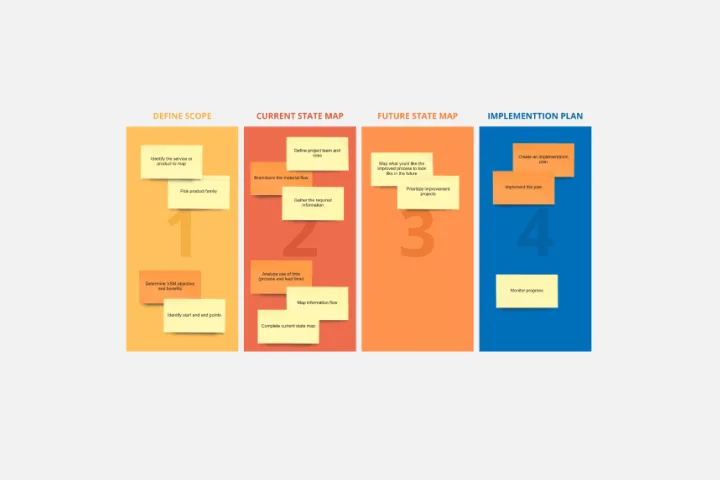Process Mapping Tool
Zeichne Prozesse, Strategien und alles, was dazwischen liegt, mit dem Prozessmapping Tool von Miro auf. Hole dir Ideen, entwickle Pläne und erstelle Konzepte, die jeder versteht, und schaffe so eine einheitliche Arbeitsweise und Flexibilität für Teams.

Komplexe Prozesse einfach lösen
Visualisiere und verdeutliche komplexe Prozesse, Systeme, Ideen, Architekturen und Organisationsstrukturen mit leistungsstarken Diagrammen, Grafiken und erweiterten Shape-Pack-Bibliotheken.

Immer auf dem neuesten Stand
Verwandle dein Miro Board in eine einzige Quelle der Wahrheit, in der Teams aktuelle Prozesse und Diagramme finden können. Durch die Einbettung von Miro Boards in Unternehmens Intranets und Wikis minimierst du das Risiko, dass veraltete Diagramme oder Prozesse jemals wieder verwendet werden.

Gestalte dein Team agiler
Das Process Maps Tool von Miro hilft dir, die aktuellen Arbeitsabläufe zu verstehen, zu optimieren und Ressourcen besser zu verwalten. Erstelle eine strukturierte visuelle Ressource, um Ideen auszutauschen, zu zeigen, wo du als Nächstes hinmusst und wie du deine Pläne strategisch planen und umsetzen kannst.

Miro als Process Mapping Tool

Von Ideenfindung zur Umsetzung
Verbessere die Kommunikation zwischen den Teams, indem du die Systeme und Prozesse von Anfang bis Ende abbildest. Hole dir neue Ideen und schaffe einen effizienten Arbeitsablauf, bei dem die Ausführung nahtlos direkt auf dem Board erfolgt.

Wiederhole für Innovation
Erkenne Einschränkungen und Engpässe, indem du Arbeitsabläufe und Prozesse über verschiedene Abteilungen hinaus abbildest. Das Prozessablauf Tool von Mir hilft dir, von Anfang an Möglichkeiten aufzudecken.

Für hybride und remote Teams
Verfolge einen einheitlichen Ansatz für die Zusammenarbeit. Vermeide Verwirrung, indem du jedem erlauben, Kommentare und sofortiges Feedback direkt auf dem Board abzugeben. Arbeite in Echtzeit oder asynchron zusammen. Die kollaborativen Funktionen von Miro, wie z. B. Live-Cursor und Notizzettel, machen es einfacher, Ideen zu formulieren und Feedback zu erfassen.

Plane Strategien wie ein Profi
Gestalte deine Strategie, lege Ziele fest und verfolge den Fortschritt mit der kostenlosen Prozessmapping Software von Miro. Bringe deinem Team deine Vision nahe und sorge dafür, dass alle auf das gleiche Ziel hinarbeiten. Miro eignet sich perfekt für den online Prozessabaluf, der Kommunikation und Arbeitsabläufe verbessert.
Process Mapping, das funktioniert
Das Process Mapping mit Miro hilft dir dabei, die aktuellen Arbeitsabläufe zu verstehen, was zu optimieren ist und wie du Ressourcen besser verwalten kannst. Erstelle eine strukturierte visuelle Ressource, um Ideen auszutauschen, zu zeigen, wo du als Nächstes hinwillst und wie du deine Pläne strategisch planen und umsetzen kannst.
Das Diagramm Tool von Miro macht den Wechsel zwischen Diagramm- und Kollaborationstools überflüssig und hilft dir dabei, alle wichtigen Schritte abzuhaken. Erstelle eine Vielzahl verschiedener Diagramme einfach und schnell.
Erfahre mehr
Erstelle Flussdiagramme im Handumdrehen und vereinfache Arbeitsabläufe und täglichen Routinen mit dem Flowchart Maker von Miro. Kreuze alle wichtigen Schritte in deinem Prozess an, von der Ausrichtung bis zur Verwertbarkeit der Informationen.
Lerne mehr
Behalte den Überblick über deine Geschäftsprozesse, indem du sie in einem BPMN Diagramm darstellst. Verschaffe dir und deinem Team ein gemeinsames Verständnis für die Abläufe in deinem Unternehmen und steigere die Produktivität im gesamten Unternehmen.
Weiterlesen
Visualisiere, entwickle und dokumentiere Softwaresysteme und -prozesse mit UML Diagrammen. Entwirf und kommuniziere deine technischen Pläne in einer einheitlichen Sprache, die jede*r versteht
Weiterlesen
Optimiere deine Prozesse und steigere die Effizienz, indem du eine Wertstromanalyse mit Miro erstellst. Nutze die Leistung deines Produktteams und schaffe Arbeitsabläufe, die Verschwendung minimieren und den Wert maximieren.
Lerne mehr
Relevante Vorlagen
Identifiziere alle relevanten Elemente eines Prozessverbesserungsplans.
Mehr erfahren
Visualisiere Ziele leicht und teile diese Komponenten auf.
Mehr erfahren
Kläre Rollen und ersetze langatmige schriftliche Prozesserläuterungen durch Grafiken.
Mehr erfahren
Definiere und optimiere die verschiedenen Schritte, die für die Bereitstellung eines Produkts erforderlich sind.
Mehr erfahren
Dieser Ansatz vereinfacht die Zusammenarbeit an Designs und die Nachverfolgung des Status.
Mehr erfahren
Visualisiere die Komponenten eines bestimmten Konzepts, Systems oder Prozesses.
Mehr erfahren

FAQs Process Mapping Tool
Was sind die Schritte für effektives Process Mapping?
Um einen Prozess effektiv abzubilden, musst du zunächst dein Ziel ermitteln und die möglichen Schritte zur Erreichung dieses Ziels aufzeigen. Um herauszufinden, welcher Arbeitsablauf für dein Team am besten geeignet ist, solltest du ein Brainstorming durchführen und die Teammitglieder befragen, um ein besseres Bild zu erhalten. Sobald du eine klare Richtung hast, organisiere deine Ergebnisse, definiere, wie Erfolg aussieht, und entwerft gemeinsam den Prozess.
Was sind die besten Tools für Process Mapping?
Es gibt viele Prozess Mapping Tools, und du musst nur ausprobieren, welches am besten zu deinem Team passt. Viele Teams wählen Miro für die Prozessabbildung wegen seiner kollaborativen Funktionen, mit denen du deinen Prozessablauf in andere Tools integrieren und in Echtzeit oder asynchron zusammenarbeiten kannst. Teste es und finde heraus, ob es die beste Lösung für dich ist.
Entdecke mehr
Starte in Sekunden
Schließe dich den Teams an, die Miro für ihre Arbeit nutzen.




